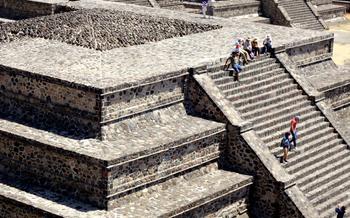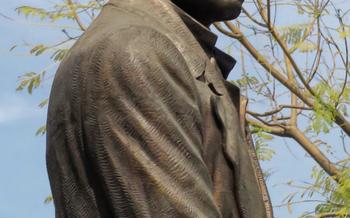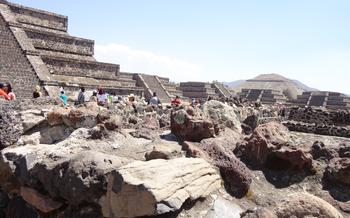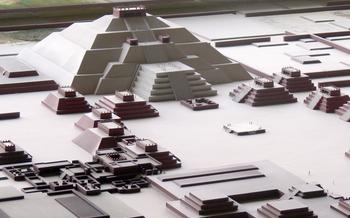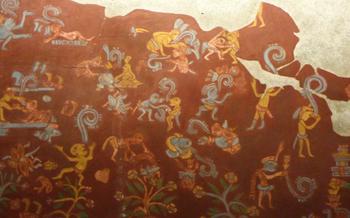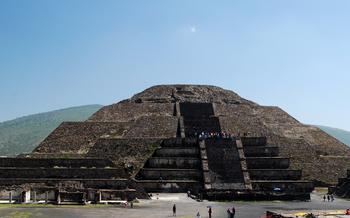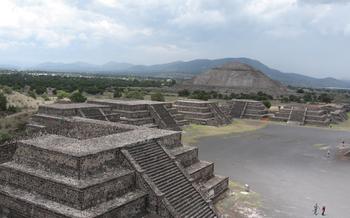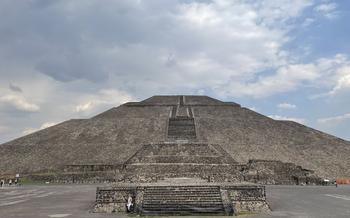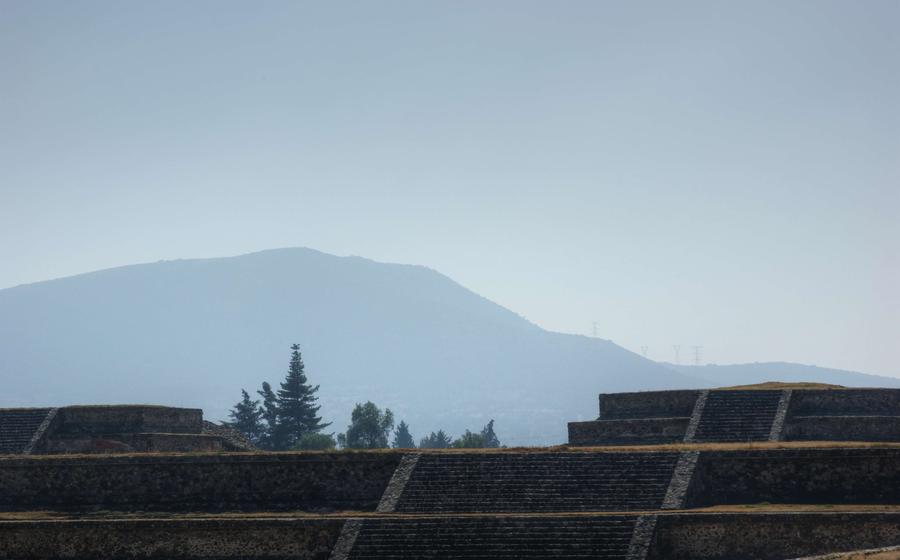
Teotihuacan Pyramids
- Historical Significance
- Getting There
- Entrance Fees and Hours of Operation
- Exploring the Pyramids
- Other Notable Structures
- Unveiling the Mysteries
- Tips for Navigating the Site
- Guided Tours
- Cultural Performances and Festivals
- Souvenir Shopping
- Local Cuisine
- Other Nearby Attractions
- Safety and Security
- Additional Resources
- Insider Tip: Unraveling the Secrets Beneath
Historical Significance
The Teotihuacan Pyramids, located just outside Mexico City, stand as testaments to the ingenuity and cultural achievements of an ancient civilization. Built by the Teotihuacanos, who flourished between 100 BC and 700 AD, these monumental structures played a crucial role in the religious, cultural, and political life of the city. The pyramids served as temples, astronomical observatories, and ceremonial centers, attracting pilgrims and traders from across Mesoamerica. The city of Teotihuacan was once one of the largest and most influential in the pre-Columbian Americas, and its pyramids remain a symbol of its grandeur and rich cultural heritage. In recognition of their exceptional value and cultural significance, the Teotihuacan Pyramids were designated a UNESCO World Heritage Site in 198
Getting There
The Teotihuacan Pyramids are situated approximately 50 kilometers (31 miles) northeast of Mexico City, an easy day trip from the capital. Reaching the site is straightforward, with several transportation options available to visitors.
For those without their own transportation, public transit offers a convenient and budget-friendly solution. The easiest route involves taking the Mexico City Metro to Indios Verdes station, where you can transfer to a bus bound for Teotihuacan. The journey takes roughly 1 hour and 30 minutes, including the metro and bus ride.
Alternatively, organized tours provide a hassle-free way to visit the pyramids, often departing from various points in Mexico City. These tours typically include round-trip transportation, guided commentary, and sometimes even lunch or additional stops at nearby attractions. Prices vary depending on the tour operator and inclusions, but expect to pay around $50-$80 per person.
If you prefer the flexibility of self-exploration, renting a car is an excellent option. The drive from Mexico City to Teotihuacan takes approximately 1 hour and 15 minutes, following the Autopista México-Pirámides toll road. Once you arrive, ample parking is available near the pyramid complex.
Entrance Fees and Hours of Operation
Visiting the Teotihuacan Pyramids requires an entrance fee. The current admission price for adults is 85 pesos (approximately 50 USD), while children and seniors over 60 years old can enter for a reduced fee of 45 pesos (approximately 25 USD). It's worth noting that these prices are subject to change, so it's always advisable to check the official website or inquire with local tourism offices for the most up-to-date information.
The pyramids are open to visitors daily from 9:00 AM to 5:00 PM, with the last admission at 4:30 PM. However, it's important to keep in mind that the site may occasionally close for special events or maintenance, so it's a good idea to plan your visit accordingly.
Exploring the Pyramids
The Teotihuacan Pyramids are imposing structures that showcase the architectural prowess of the ancient civilization. Among them, the Sun Pyramid (Pirámide del Sol) stands as the largest, reaching an impressive height of 213 feet. It was built as a temple dedicated to the sun god Tonatiuh and is the third-largest pyramid in the world by volume. Visitors can climb the 248 steps to the top for breathtaking panoramic views of the entire complex and the surrounding landscape.
The Moon Pyramid (Pirámide de la Luna), the second-largest pyramid at Teotihuacan, boasts a height of 137 feet. It holds significant religious importance as it aligns with the moon's cycles and is believed to have been used for astronomical observations. Atop the pyramid lies the Temple of Quetzalcoatl, dedicated to the feathered serpent god. The temple features intricate carvings and sculptures depicting various deities and mythical creatures.
The Avenue of the Dead (Calzada de los Muertos) is the main thoroughfare of Teotihuacan, stretching for over 5 miles. It connects the Moon Pyramid with the Sun Pyramid and is lined with various temples, palaces, and residential compounds. Strolling along the avenue allows visitors to immerse themselves in the city's ancient layout and admire its impressive architecture.
Other Notable Structures
Beyond the iconic Sun and Moon Pyramids, Teotihuacan boasts several other remarkable structures that offer a glimpse into the city's rich history and culture.
-
Temple of Quetzalcoatl (Templo de Quetzalcóatl): This temple, dedicated to the feathered serpent god Quetzalcoatl, stands out with its unique architectural style. Its façade is adorned with intricate carvings depicting the deity, as well as rows of feathered serpent heads that appear to slither down the structure. The temple's interior boasts a series of chambers, each adorned with vibrant murals depicting scenes from Teotihuacan mythology.
-
Ciudadela (Citadel): The Ciudadela, a massive complex located near the Avenue of the Dead, once served as an administrative and religious center. Within its walls, visitors can explore various structures, including the Temple of the Feathered Shells, with its elaborate seashell-shaped carvings, and the Great Compound, a series of courtyards and platforms that likely hosted important ceremonies.
-
Palace of Quetzalpapálotl (Palacio de Quetzalpapálotl): This former royal residence, named after the butterfly goddess Quetzalpapálotl, offers a glimpse into the opulent lifestyle of Teotihuacan's elite. The palace features well-preserved murals showcasing scenes of daily life, including feasting, dancing, and rituals. Its state of preservation makes it one of the most significant residential structures in the ancient city.
Unveiling the Mysteries
The Teotihuacan Pyramids continue to captivate scholars and historians with their enigmatic origins and purpose. Extensive archaeological research has been conducted to unravel the secrets of this ancient city, but many questions remain unanswered.
Theories abound regarding the construction and significance of the pyramids. Some believe that they served as religious temples, while others suggest they were astronomical observatories or even tombs for the city's rulers. The precise function of the pyramids remains a subject of ongoing debate.
The ancient Teotihuacan civilization, which flourished from around 100 BC to 700 AD, was highly advanced for its time. They developed a complex system of writing, mathematics, and engineering, as evidenced by the sophisticated construction of the pyramids and other structures. Their religious beliefs and practices were intricate and played a central role in their daily lives.
Uncovering the mysteries of the Teotihuacan Pyramids is an ongoing endeavor, and new discoveries are continuously being made. Archaeological excavations, studies of ancient artifacts, and ongoing research are shedding light on the fascinating history and culture of this ancient civilization.
Tips for Navigating the Site
To make the most of your visit to the Teotihuacan Pyramids, consider the following tips:
-
Timing is key: For a more serene experience, aim to arrive early in the morning before the crowds descend. Alternatively, visit towards the late afternoon to capture the magical glow of the sunset.
-
Dress comfortably: The pyramid complex involves a fair amount of walking on uneven surfaces. Choose comfortable shoes and breathable clothing to ensure a pleasant exploration.
-
Protect yourself from the elements: The Mexican sun can be intense, so be sure to bring sunscreen, sunglasses, and a hat. Carry a water bottle to stay hydrated, especially during the warmer months.
Guided Tours
Embarking on a guided tour of the Teotihuacan Pyramids offers a multitude of benefits. Certified guides possess a wealth of historical knowledge and local insights, transforming your visit into an immersive educational experience. They will regale you with captivating tales of the ancient Teotihuacan civilization, bringing the site's rich history to life.
Opting for a group tour allows you to share the experience with fellow travelers and engage in lively discussions about the pyramids' significance. Alternatively, private tours provide an intimate and personalized exploration, catering to your specific interests and allowing for a more in-depth exploration of the site.
Booking your tour in advance is highly recommended, especially during peak tourist seasons. Numerous reputable tour operators offer a range of options to suit different budgets and preferences. Be sure to read reviews and compare prices to find the best fit for your needs.
Cultural Performances and Festivals
The vibrant culture of Mexico is brought to life at the Teotihuacan Pyramids through captivating traditional Aztec dance performances and mesmerizing music. These performances showcase the rich heritage of the ancient Teotihuacan civilization, allowing visitors to witness the intricate movements and rhythmic beats that have been passed down through generations.
In addition to these captivating performances, annual festivals are held in the vicinity of the pyramids, attracting both locals and tourists alike. These festivals offer a unique opportunity to immerse oneself in the vibrant Mexican culture, with colorful processions, lively music, traditional dances, and a festive atmosphere that permeates the air.
Attending these cultural events provides an unforgettable experience, allowing visitors to connect with the living traditions of the region and gain a deeper appreciation for the rich tapestry of Mexican heritage.
Souvenir Shopping
As you depart from the wondrous Teotihuacan Pyramids, don't miss the opportunity to immerse yourself in the vibrant local culture through souvenir shopping. Near the pyramids, you'll find an array of artisan markets and shops brimming with authentic handicrafts, pottery, and textiles that showcase the artistry and traditions of the region.
From intricately hand-painted ceramics to colorful woven textiles, these souvenirs serve as a tangible reminder of your time in Mexico City. You'll find vendors selling traditional Mexican crafts, such as alebrijes (whimsical clay sculptures), papier-mâché masks, and intricately beaded jewelry.
By purchasing local handicrafts, you not only take home a unique memento but also support the livelihoods of talented artisans and help preserve their cultural heritage. Engage with the friendly vendors, learn about their techniques, and contribute to the sustainability of this vibrant community.
Local Cuisine
When visiting the Teotihuacan Pyramids, immerse yourself in the rich flavors of Mexican cuisine. Savor traditional dishes like barbacoa, a slow-cooked meat delicacy, or indulge in tacos al pastor, a spit-roasted pork specialty. Don't miss the chance to try pulque, a fermented beverage made from maguey sap, or savor the sweetness of traditional Mexican desserts like churros and buñuelos. Food stalls and restaurants near the pyramids offer a variety of local delicacies, allowing you to experience the culinary heritage of Mexico City. Embrace the opportunity to taste the authentic flavors of the region and enjoy a memorable gastronomic journey alongside your exploration of the ancient pyramids.
Other Nearby Attractions
In addition to the pyramids, several other notable attractions are worth exploring in the vicinity of Teotihuacan. Just a short distance away, the Templo de San Francisco Acatepec stands as a testament to the region's rich colonial history. This 16th-century Franciscan church boasts stunning architecture, intricate murals, and a peaceful ambiance that invites contemplation.
For those seeking a spiritual experience, the Basilica de Guadalupe is an essential destination. Located a bit further from the pyramids, this iconic pilgrimage site attracts millions of visitors each year. Dedicated to the Virgin of Guadalupe, Mexico's patron saint, the basilica offers a profound spiritual connection and awe-inspiring architecture.
Finally, don't miss the opportunity to visit the charming town of San Juan Teotihuacan, a traditional Otomi village nestled near the pyramids. Immerse yourself in the local culture as you explore the vibrant markets, browse authentic handicrafts and textiles, and savor delicious regional cuisine. San Juan Teotihuacan offers a glimpse into the rich cultural heritage of the region, providing a perfect complement to your exploration of the ancient pyramids.
Safety and Security
When exploring the Teotihuacan Pyramids, your safety should be a top priority. Mexico is generally a safe country for tourists, but it's essential to be aware of potential risks and take necessary precautions. Here are some safety tips to keep in mind:
- Be vigilant and aware of your surroundings. Avoid walking alone at night, especially in poorly lit areas.
- Protect your belongings. Keep your valuables securely stored and avoid carrying large amounts of cash.
- Be cautious of scams. Be wary of individuals offering unsolicited services or selling counterfeit goods.
- Respect local customs and traditions. Dress modestly, avoid taking photos of people without their permission, and be mindful of religious and cultural sensitivities.
By following these safety tips, you can ensure a safe and enjoyable visit to the Teotihuacan Pyramids.
Additional Resources
To further delve into the fascinating world of the Teotihuacan pyramids, I highly recommend the following resources:
- Books:
- "Teotihuacan: City of the Gods" by Richard A. Diehl
- "The Sun, the Moon, and the Stars: The Cult of the Astral Deities in Ancient Teotihuacan" by George Kubler
- Documentaries:
- "Teotihuacan: City of the Gods" (National Geographic)
- "The Mystery of Teotihuacan" (BBC)
- Websites:
- Teotihuacan official website: https://teotihuacan.gob.mx/
- Mexican National Institute of Anthropology and History (INAH): https://www.inah.gob.mx/
- Teotihuacan Archaeological Project: http://www.teotihuacan.inah.gob.mx/
You can also connect with fellow travelers and enthusiasts through travel blogs and forums such as TripAdvisor, Lonely Planet, and Reddit. Share your experiences, ask questions, and learn from the insights of others.
For official information, guidance, and tour arrangements, you can contact local tourism offices or tour operators. Here are some useful contacts:
- Mexico City Tourism Board: https://www.cdmxtravel.com/
- Teotihuacan Tourism Office: https://www.teotihuacan.gob.mx/turismo/
- GetYourGuide: https://www.getyourguide.com/teotihuacan-l372/
- Viator: https://www.viator.com/Mexico-City-tours/d441-ttd
These resources will enrich your understanding of Teotihuacan's history, culture, and significance, making your visit even more rewarding and memorable.
Insider Tip: Unraveling the Secrets Beneath
For the most adventurous and curious travelers, a hidden gem awaits beneath the Teotihuacan Pyramids. Limited access to the tunnels that run beneath these colossal structures offers a unique opportunity to delve into the secrets of the ancient city. With special arrangements and guided tours, you can embark on an underground journey to discover hidden chambers, passageways, and artifacts that shed light on the enigmatic civilization that once thrived here. Prepare to be amazed as you uncover the mysteries that lie buried beneath the surface of Teotihuacan, revealing a whole new perspective on this iconic archaeological site.
